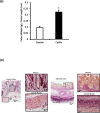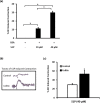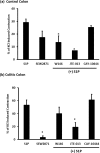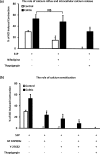The effect of sphingosine-1-phosphate on colonic smooth muscle contractility: Modulation by TNBS-induced colitis
- PMID: 28493876
- PMCID: PMC5426588
- DOI: 10.1371/journal.pone.0170792
The effect of sphingosine-1-phosphate on colonic smooth muscle contractility: Modulation by TNBS-induced colitis
Abstract
Aim: Increased levels of circulating sphingosine-1-phosphate (S1P) have been reported in ulcerative colitis. The objective of this study was to examine the effect of S1P on colonic smooth muscle contractility and how is it affected by colitis.
Methods: Colonic inflammation was induced by intrarectal administration of trinitrobenzene sulfonic acid. Five days later colon segments were isolated and used for contractility experiments and immunoblotting.
Results: S1P contracted control and inflamed colon segments and the contraction was significantly greater in inflamed colon segments. S1P-induced contraction was mediated by S1PR1 and S1PR2 in control and S1PR2 in inflamed colon segments. S1PR3 did not play a significant role in S1P-induced contractions in control or inflamed colon. S1PR1, S1PR2 and S1PR3 proteins were expressed in colon segments from both groups. The expression of S1PR1 and S1PR2 was significantly enhanced in control and inflamed colon segments, respectively. S1PR3 levels however were not significantly different between the two groups. Nifedipine significantly reduced S1P-induced contraction in control but not inflamed colon segments. Thapsigargin significantly reduced S1P-induced contraction of the inflamed colon. GF 109203X and Y-27632, alone abolished S1P-induced contraction of the control but not inflamed colon segments. Combination of GF 109203X, Y-27632 and thapsigargin abolished S1P-induced contraction of inflamed colon segments.
Conclusion: S1P contracted control colon via S1PR1 and S1PR2 and inflamed colon exclusively via S1PR2. Calcium influx (control) or release (inflamed) and calcium sensitization are involved in S1P-induced contraction. Exacerbated response to S1P in colitic colon segments may explain altered colonic motility reported in patients and experimental models of inflammatory bowel disease.
Conflict of interest statement
Figures






Similar articles
-
Role of Ca2+-sensitization in attenuated carbachol-induced contraction of the colon in a rat model of colitis.Eur J Pharmacol. 2008 Jan 28;579(1-3):365-73. doi: 10.1016/j.ejphar.2007.10.069. Epub 2007 Nov 1. Eur J Pharmacol. 2008. PMID: 18037403
-
Downregulation of sphingosine-1-phosphate receptors in bronchial smooth muscle of mouse experimental asthma.Pharmacol Res. 2010 Oct;62(4):357-63. doi: 10.1016/j.phrs.2010.05.005. Epub 2010 Jun 8. Pharmacol Res. 2010. PMID: 20554039
-
Enhancement of S1P-induced contractile response in detrusor smooth muscle of rats having cystitis.Eur J Pharmacol. 2017 Nov 5;814:343-351. doi: 10.1016/j.ejphar.2017.08.043. Epub 2017 Sep 4. Eur J Pharmacol. 2017. PMID: 28882559
-
The role of sphingosine-1-phosphate in smooth muscle contraction.Cell Signal. 2005 Mar;17(3):289-98. doi: 10.1016/j.cellsig.2004.09.013. Cell Signal. 2005. PMID: 15567060 Review.
-
Sphingosine-1-phosphate receptor 3 signaling.Clin Chim Acta. 2021 Aug;519:32-39. doi: 10.1016/j.cca.2021.03.025. Epub 2021 Mar 31. Clin Chim Acta. 2021. PMID: 33811927 Review.
Cited by
-
Vegetal diamine oxidase alleviates histamine-induced contraction of colonic muscles.Sci Rep. 2020 Dec 9;10(1):21563. doi: 10.1038/s41598-020-78134-3. Sci Rep. 2020. PMID: 33299054 Free PMC article.
-
Sphingosine-1-Phosphate Signaling and Metabolism Gene Signature in Pediatric Inflammatory Bowel Disease: A Matched-case Control Pilot Study.Inflamm Bowel Dis. 2018 May 18;24(6):1321-1334. doi: 10.1093/ibd/izy007. Inflamm Bowel Dis. 2018. PMID: 29788359 Free PMC article.
-
Unveiling the biological role of sphingosine-1-phosphate receptor modulators in inflammatory bowel diseases.World J Gastroenterol. 2023 Jan 7;29(1):110-125. doi: 10.3748/wjg.v29.i1.110. World J Gastroenterol. 2023. PMID: 36683721 Free PMC article. Review.
References
-
- Zhang YZ, Li YY. Inflammatory bowel disease: pathogenesis. World J Gastroenterol. 2014;20(1):91–9. PubMed Central PMCID: PMC3886036. doi: 10.3748/wjg.v20.i1.91 - DOI - PMC - PubMed
-
- Coulie B, Camilleri M, Bharucha AE, Sandborn WJ, Burton D. Colonic motility in chronic ulcerative proctosigmoiditis and the effects of nicotine on colonic motility in patients and healthy subjects. Aliment Pharmacol Ther. 2001;15(5):653–63. - PubMed
-
- Sethi AK, Sarna SK. Colonic motor activity in acute colitis in conscious dogs. Gastroenterology. 1991;100(4):954–63. - PubMed
-
- Snape WJ Jr. The role of a colonic motility disturbance in ulcerative colitis. The Keio journal of medicine. 1991;40(1):6–8. - PubMed
-
- Bassotti G, de Roberto G, Chistolini F, Sietchiping-Nzepa F, Morelli O, Morelli A. Twenty-four-hour manometric study of colonic propulsive activity in patients with diarrhea due to inflammatory (ulcerative colitis) and non-inflammatory (irritable bowel syndrome) conditions. Int J Colorectal Dis. 2004;19(5):493–7. doi: 10.1007/s00384-004-0604-6 - DOI - PubMed
MeSH terms
Substances
LinkOut - more resources
Full Text Sources
Other Literature Sources
Medical

